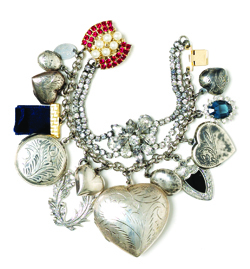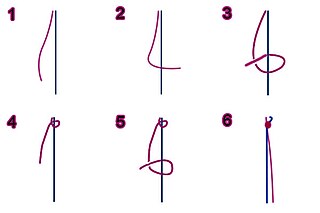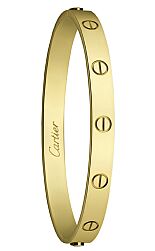
A bracelet is an article of jewellery that is worn around the wrist. Bracelets may serve different uses, such as being worn as an ornament. When worn as ornaments, bracelets may have a supportive function to hold other items of decoration, such as charms. Medical and identity information are marked on some bracelets, such as allergy bracelets, hospital patient-identification tags, and bracelet tags for newborn babies. Bracelets may be worn to signify a certain phenomenon, such as breast cancer awareness, or for religious/cultural purposes.

An anklet, also called ankle chain, ankle bracelet or ankle string, is an ornament worn around the ankle. Barefoot anklets and toe rings historically have been worn for at least over 8,000 years by girls and women in Indus Valley, in South Asia where it is commonly known as pattilu, payal, golusu and sometimes as nupur. They have also been worn by Egyptian women since predynastic times. In the United States both casual and more formal anklets became fashionable from the 1930s to the late–20th century. While in Western popular culture both younger men and women may wear casual leather anklets, they are popular among barefoot women. Formal anklets are used by some women as fashion jewellery. Anklets are an important piece of jewellery in Indian marriages, worn along with saris.

Cufflinks are items of jewelry that are used to secure the cuffs of dress shirts. Cufflinks can be manufactured from a variety of different materials, such as glass, stone, leather, metal, precious metal or combinations of these. Securing of the cufflinks is usually achieved via toggles or reverses based on the design of the front section, which can be folded into position. There are also variants with chains or a rigid, bent rear section. The front sections of the cufflinks can be decorated with gemstones, inlays, inset material or enamel and designed in two or three-dimensional forms.

Wristbands are encircling strips worn on the wrist or lower forearm. The term may refer to a bracelet-like band, similar to that of a wristwatch, to the cuff or other part of a sleeve that covers the wrist, or decorative or functional bands worn on the wrist for many different reasons. Wristbands are often worn and used similarly to event passes such as lanyards to information or allow people entry to events. These wristbands are made from loops of plastic that are placed around the wrist and are used for identification purposes.

Slave bracelet may refer to:

A charm bracelet is a type of bracelet which carries personal jewelled ornaments or "charms", such as decorative pendants or trinkets. The decorative charms usually carry personal or sentimental attachment by the owner.

Gel bracelets are a type of wristband often made from silicone.

An Italian Charm bracelet, also known in the US as a Nomination bracelet, is a series of individual modular links hooked together on a stretchy band to form a single charm bracelet. A typical Italian charm bracelet comprises eighteen charm links. Each link features a charming face soldered onto the actual charm link.

A friendship bracelet is a decorative bracelet given by one person to another as a symbol of friendship. Friendship bracelets are often handmade, usually of embroidery floss or thread and are a type of macramé. There are various styles and patterns, but most are based on the same simple half-hitch knot. They represent a friendship that is strong and everlasting.

Speidel is a manufacturer of watchbands and related items based in East Providence, Rhode Island, United States. It was originally founded in Germany by Friedrich Speidel in 1867 as a manufacturer of gold and silver chains. The Speidel Chain Company was formed in its modern state in the United States in 1904. It was known for its "Ratchet-buckle" watchbands, the "Scissors Action Expansion Band", the ladies' "Mignon" watchbands, plus costume jewelry. In the 1930s, Speidel was the first company in the world to introduce ID bracelets. During World War II, the company briefly produced cathode-ray tubes. Speidel experienced a boom in popularity, notably with their invention of the hugely popular expanding strap in the mid-1930s, and in addition to watchbands Speidel produced wristwatches, lighters, writing instruments, small jewelry, and other accessories, before beginning to decline by the end of the century with the struggle to compete with cheaper overseas production, and the boom in quartz watches.

Hairwork, or jewelry or artwork made of human hair, has appeared throughout the history of craft work, particularly to be used for private worship or mourning. From the Middle Ages through the early twentieth century, memorial hair jewelry remained common. Hair, considered to be a remnant off the person it was cut from, also has often played a part in myths and legends; in a Swedish book of proverbs, one can read that “rings and bracelets of hair increase love”. One example can be found in Denmark, at Rosensborg’s palace, which is a bracelet of precious metal with a simple braided lock of hair - a gift from King Christian IV (1577-1648) to his queen. Another example would be the rings commemorating the execution of King Charles I of England (1600-1649), which circulated among his faithful supporters. Other famous people who owned hair jewelry include Napoleon, Admiral Nelson, Queen Victoria and her large family, Christina Nilsson and Jenny Lind.

The World Series of Poker (WSOP) bracelet is considered the most coveted non-monetary prize a poker player can win. Since 1976, a bracelet has been awarded to the winner of every event at the annual WSOP. Even if the victory occurred before 1976, WSOP championships are now counted as "bracelets". During the first years of the WSOP, only a handful of bracelets were awarded each year. In 1990, there were only 14 bracelet events. By 2000, that number increased to 24. As the popularity of poker has increased during the 2000s, the number of events has likewise increased. In 2011, 58 bracelets were awarded at the WSOP, seven at the World Series of Poker Europe (WSOPE), and one to the WSOP National Circuit Champion. This brought the total number of bracelets awarded up to 959. Five additional bracelets were awarded for the first time in April 2013 at the inaugural World Series of Poker Asia-Pacific in Melbourne, Australia. In 2017, 74 bracelets were awarded at the WSOP and an additional 11 will be awarded at the WSOPE in Czech Republic.

The Napier Company is an American jewelry manufacturing company, and was one of the first modern corporations in the United States. The company is also known historically as a cutting-edge silver object manufacturer.
An Ionized bracelet, or ionic bracelet, is a type of metal bracelet jewelry purported to affect the chi of the wearer. No claims of effectiveness made by manufacturers have ever been substantiated by independent sources, and the US Federal Trade Commission (FTC) has found the bracelets are "part of a scheme devised to defraud".

The Love Bracelet is a piece of jewelry designed in 1969 by Aldo Cipullo and offered to Cartier SA. Early versions of the Love Bracelet featured gold plating, while more recent designs are created from solid gold or platinum. Prices for the bracelets differ depending on the item's materials. As of 2019, the Love Bracelet is still in production and Cartier has expanded the line to include products based on the original bracelet's design, including cufflinks, rings, earrings, necklaces, and watches. In 2006 the line was considered to be the "most successful collection in Cartier's history."
Victorian jewellery originated in England. Victorian jewellery was produced during the reign of Queen Victoria, whose reign lasted from 1837 to 1901. Queen Victoria was an influential figure who established the different trends in Victorian jewellery. The amount of jewellery acquired throughout the Victorian era established a person’s identity and status. Within the Victorian period, jewellery consisted of a diverse variety of styles and fashions. These periods can be categorised into three distinct timeframes: The Romantic period, the Grand period and the Aesthetic period.
Daisy London is a British jewellery brand founded in 2009. It has an e-commerce platform and distributor in UK and internationally.
The salvation bracelet, also known as the gospel bracelet, witness bracelet, or wordless bracelet, is a bracelet used as a tool of Christian evangelism. The bracelet consists of a series of colored beads which represent key aspects of the Christian gospel.

Jewels! The Glitter of the Russian Court was the second jubileum exhibition in Amsterdam by the H'ART Museum, focussed on the personal taste for luxury by Russian nobility. The show, which was planned to run from 14 September 2019 to 15 March 2020, suffered from the pandemic and was extended twice, ending finally 16 October 2020.














